Top 9 data integration platforms & finding the best fit
Top 9 data integration platforms & finding the best fit
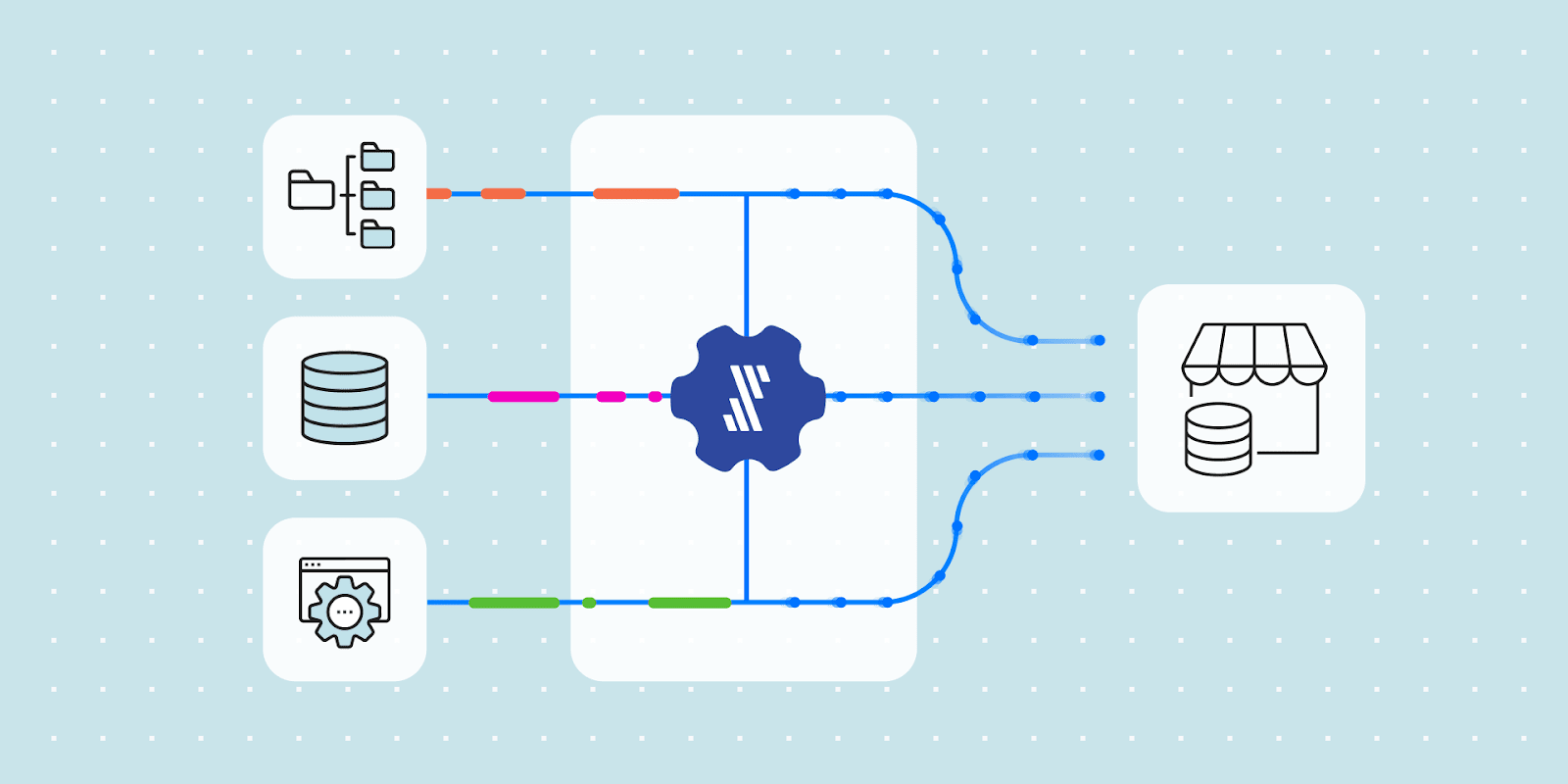
Data integration platforms enable companies to combine data from different sources into clear, actionable insights. As companies carry out their day-to-day operations, they generate data from internal departments, business applications, external contractors, and other sources. Collecting, storing, and analyzing this data has become important in making strategic decisions and improving efficiency.
With a variety of solutions available, it can be overwhelming for you to select one that fits your needs.
This article compares nine of the best data integration platforms, using five critical criteria to help you select the proper data integration tool for your company.
What to look for in a data integration platform
Knowing what to look for in a data integration platform can help you choose a solution with capabilities that match your workflows, data sources, and team expertise.
Use the criteria below to evaluate each tool against your organization’s needs.
Rapid data processing
Rapid data processing, analysis, and insights are crucial. Quick data-backed suggestions enable organizations to be more agile and gain a competitive edge.
Multi-source support
Integration platforms that restrict specific sources or limit the number of active connections can bottleneck data extraction and analysis efforts. Before seriously considering a platform, make sure it can pull from all the databases, SaaS applications, and other systems your organization uses.
Scalability
Cloud-based platforms are easier to scale without additional engineering overhead. Fivetran and many other cloud-native platforms offer usage-based pricing and instant access to additional connectors or features without needing additional reconfiguration.
Compliance and security
Data leaks can cost companies millions of dollars in fines, legal claims, and a loss of customer trust. To meet compliance requirements and build trust, prioritize platforms with top-notch encryption, granular access control, and detailed audit logs.
Dynamic data transformations
If you’re using ELT for data integration, you need a platform with pre-built transformations to create an efficient, automated workflow.
Once loaded to your destination, data models can immediately transform data and further reduce the time needed to gain actionable data insights.
Top 9 data integration platforms
We’ve compiled overviews of 9 top data integration platforms to help you find the best platform for your team’s needs.
The tool overviews below explain each tool’s critical features, supported data sources, integration types, ideal use cases, and pricing structures.
1. Fivetran
Best for: Operationalizing data from different sources with minimal overhead

Fivetran is a fully managed data integration platform that uses connectors and APIs to pull fresh data from a wide variety of sources. It automatically captures API and schema changes, so it requires minimal maintenance.
Supported data sources
700+ connectors, including Salesforce, Big Commerce, Stripe, databases (MySQL, PostgreSQL, SQL Server, MongoDB), cloud storage (S3, Google Cloud Storage), and marketing platforms.
Integration types
- Extract Load Transform (ELT)
- Reverse ETL
- Near real-time sync for select sources
- Change Data Capture (CDC)
Ideal use cases
- Marketing analytics and attribution modelling
- Sales and CRM data consolidation
- Financial reporting and business intelligence
- Data warehouse modernization projects
Fivetran pricing structure
- Usage-based, calculated by Monthly Active Rows (MAR) and Monthly Model Runs (MMR)
- A free tier is available for transformations of up to 500,000 MAR and 5,000 MMR.
- Standard, Enterprise, and Business Critical plans provide additional features like faster sync frequencies, enterprise connectors, and advanced security.
- Pricing for paid plans varies based on data volume and usage requirements.
2. Talend
Best for: Teams with complex data transformation and deep customization needs.
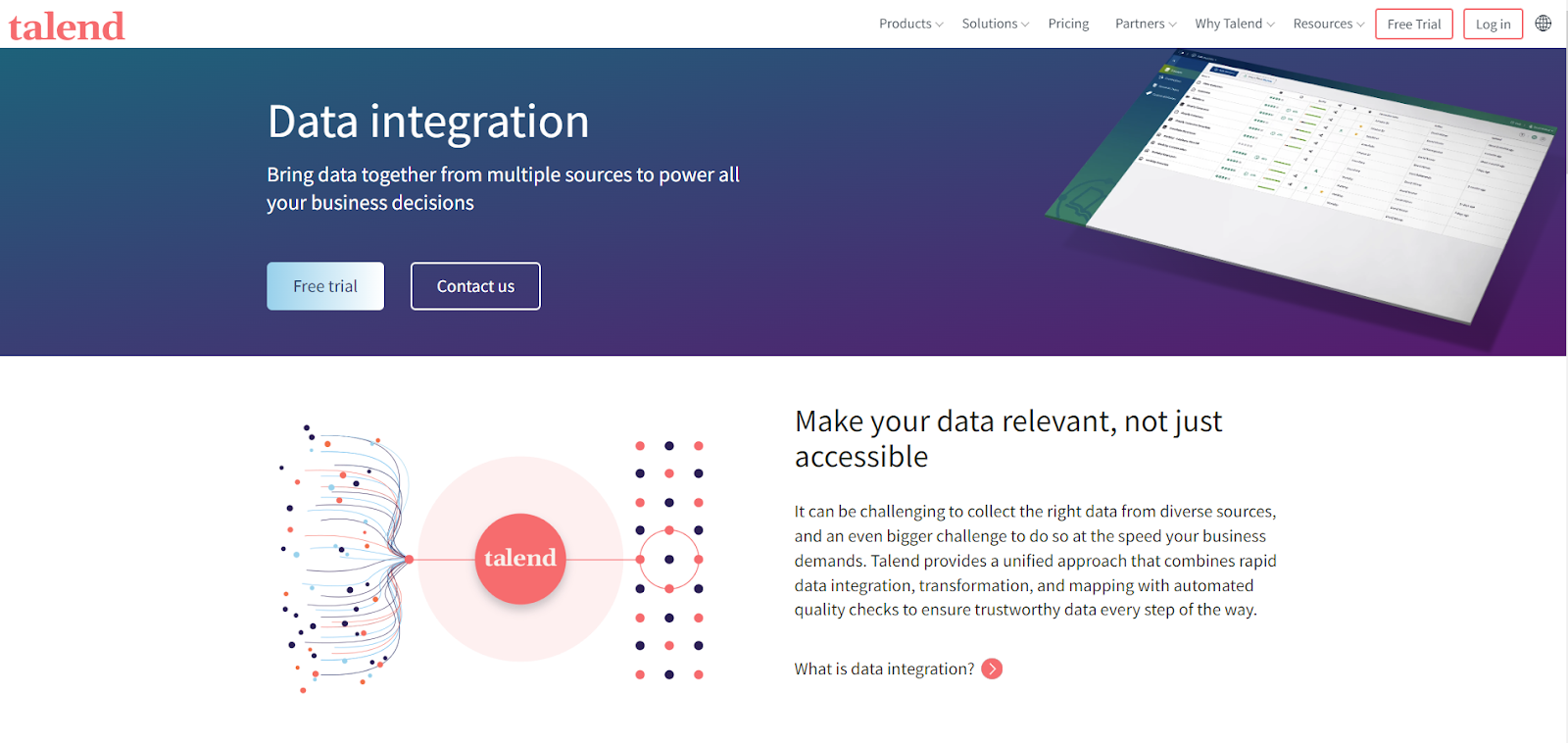
Talend is an open-source integration platform providing visual ETL tools with design and code generation capabilities. It offers extensive transformation components and can deploy jobs to different architectures, including cloud, on-premise, and hybrid setups.
Supported data sources
1000+ connectors, including databases, cloud applications, file systems, messaging queues, IoT devices, and API connections.
Integration types
- Extract, Transform, Load (ETL)
- Extract, Load, Transform (ELT)
- API-based integration
- Real-time data streaming
- Reverse ETL
Ideal use cases
- Enterprise data warehousing and analytics.
- Real-time operational dashboards and monitoring.
- Cloud migration and hybrid data architectures.
Talend pricing structure
- Offers Starter, Standard, Premium, and Enterprise subscription tiers.
- These plans include features from basic SaaS integration and cloud pipelines to advanced CDC, automated transformations, and data lineage tracking.
3. Informatica
Best for: Enterprise-level data integration in complex multi-system environments.
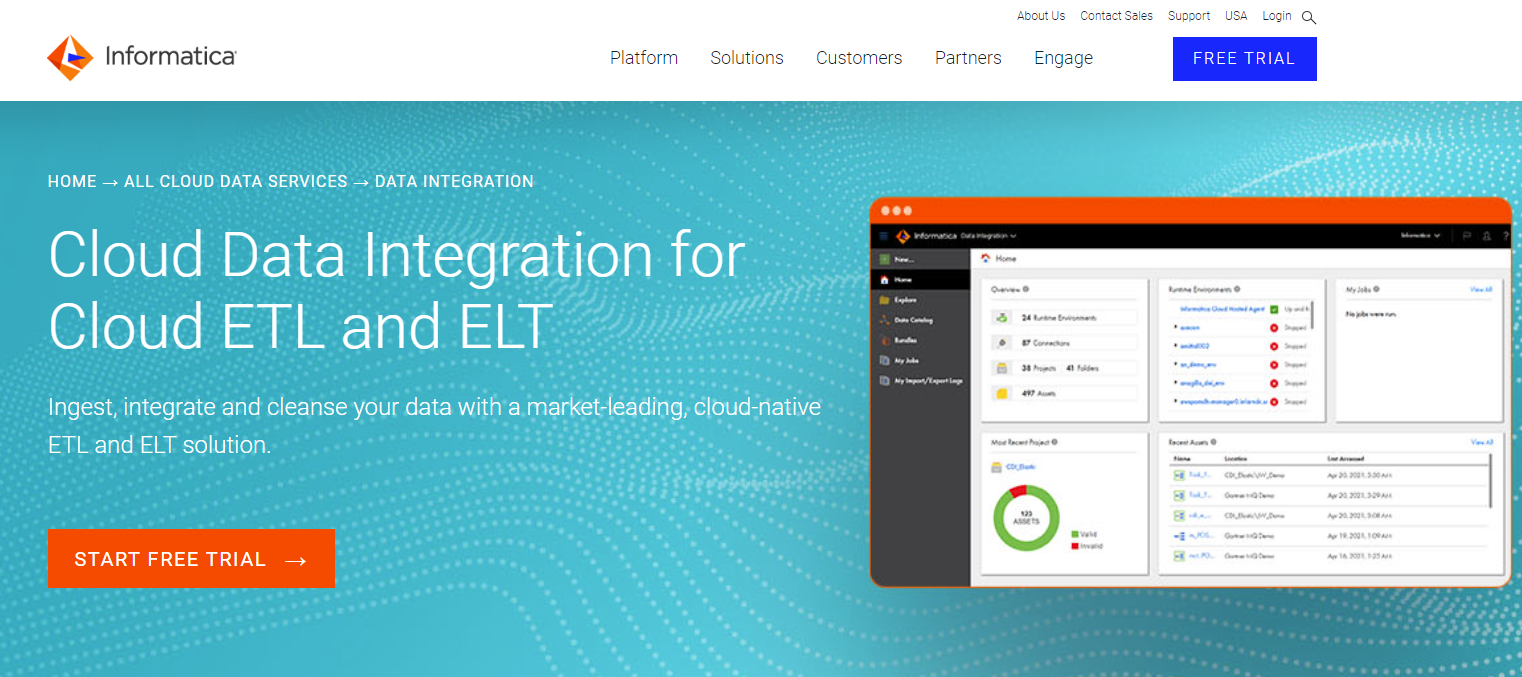
Informatica is a data management platform offering both on-premises and cloud-native solutions for data quality, integration, and governance. It provides visual development tools, comprehensive transformation capabilities, and enterprise-level security.
Supported data sources
Connectors, including enterprise database (Oracle, DB2, Teradata, SAP HANA), cloud platforms (AWS, Azure), Saas platforms (Salesforce), and real-time streaming sources (Amazon Kinesis Streams, Kafka).
Integration types
- Extract, Transform, Load (ETL)
- Extract, Load, Transform (ELT)
- Real-time data streaming and messaging
- Change Data Capture (CDC)
- API-based integrations and web services
Ideal use cases
- Enterprise data warehousing
- Regulatory compliance and data governance initiatives
- Master data management (MDM) implementations
- Data migration and modernization projects.
Informatica pricing structure
- Pricing is based on Informatica Pricing Units (IPUs).
- Annual pre-payment is required.
- This model provides access to Informatica's services, connectors, and processing engines.
4. Dell Boomi
Best for: Connecting disparate systems in highly regulated industries
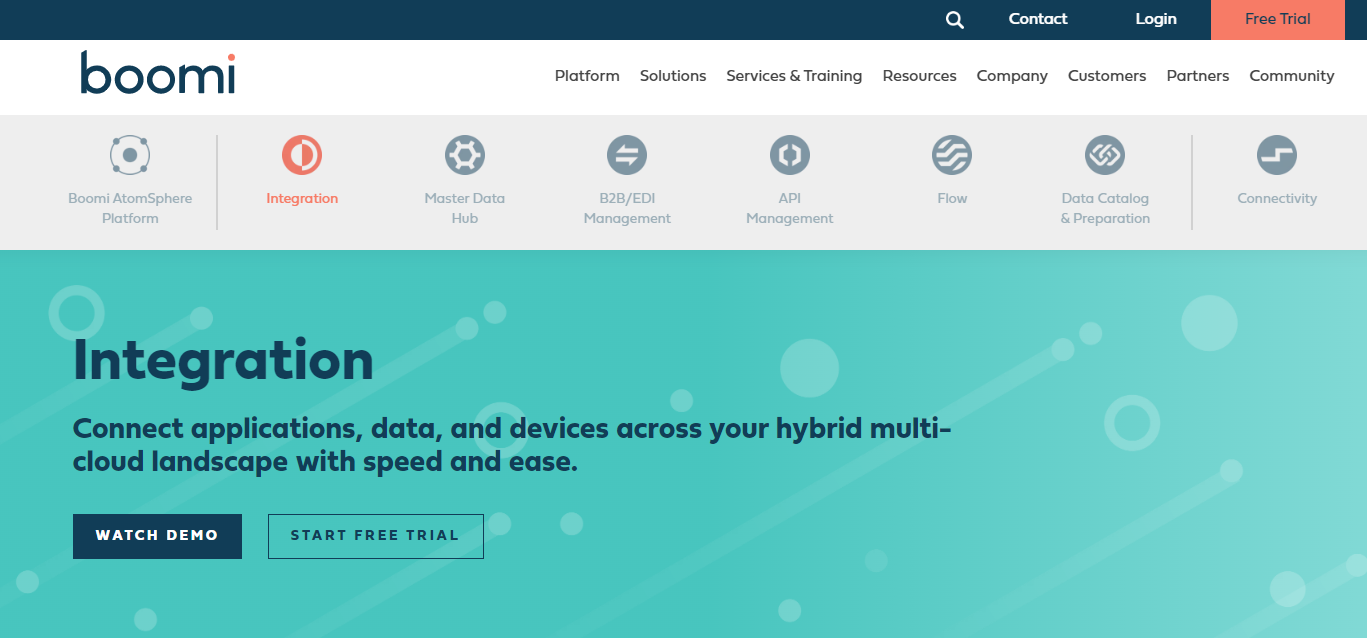
Boomi is an integration Platform as a Service (iPaaS) that provides low-code data integration, API management, and workflow automation. It offers a visual drag-and-drop interface with pre-built templates and connectors for implementation.
Supported data sources
Cloud applications (Salesforce, Netsuite, Workday, ServiceNow), Databases (PostgreSQL, MySQL, Oracle, SQL Server), file systems, EDI formats, APIs, and on-premises enterprises like SAP.
Integration types
- Extract, Load, Transform (ELT)
- Extract, Transform, Load (ETL)
- Real-time API-based integrations
- Event-driven data synchronization
- B2B/EDI data exchange
- Hybrid cloud and on-premise connectivity through Boomi Atom runtime engines
Ideal use cases
- SaaS application integration and synchronization
- API development and management
- B2B Partner integrations and EDI processing
- Cloud migration and hybrid architecture support
- Workflow automation and business process integration
Boomi pricing structure
- Free trial offer
- A pay-as-you-go option is available starting at $99 per month.
5. SnapLogic
Best for: AI-powered, low-code integration across applications, data, and APIs.
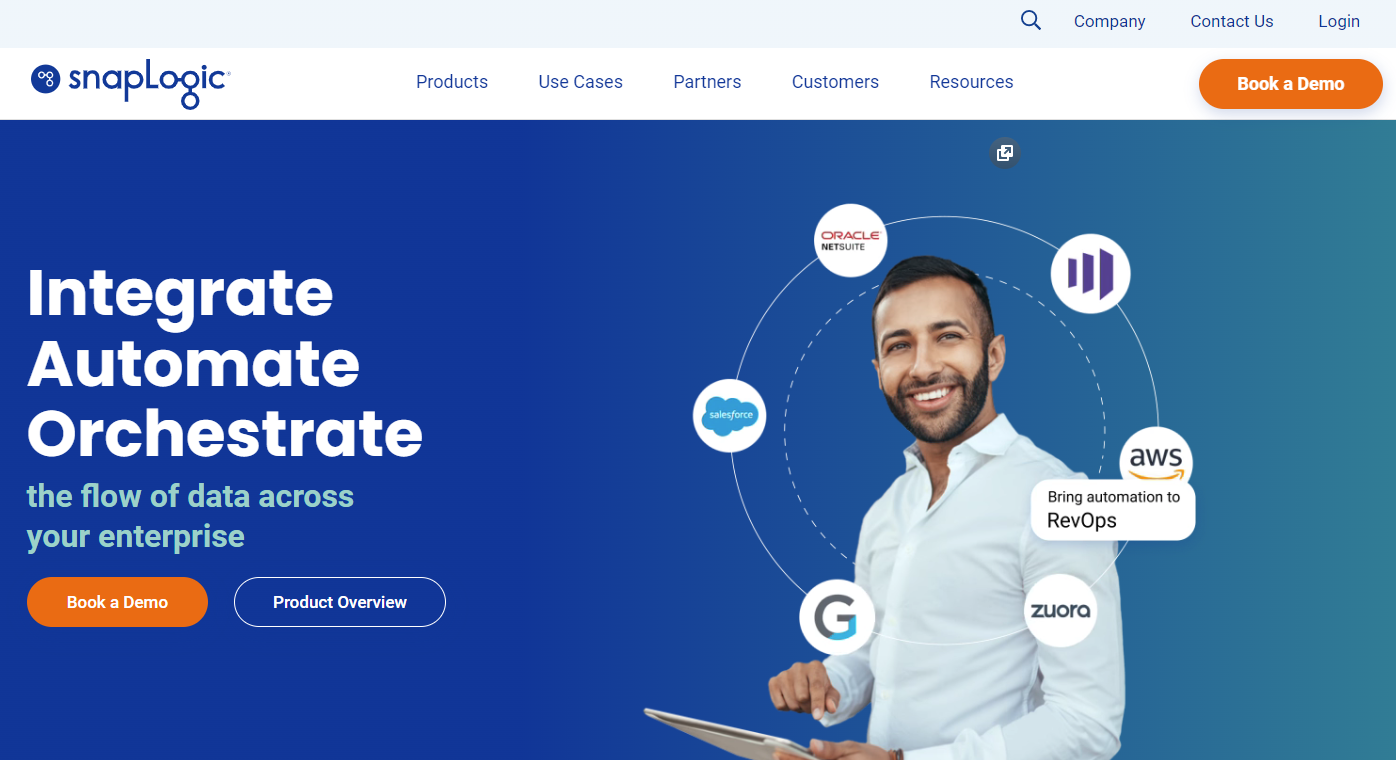
SnapLogic is a data integration Platform as a Service (iPaaS) that brings together visual, drag-and-drop pipeline development with AI-assisted data mapping and transformation suggestions.
Supported data sources
Cloud applications (Salesforce, ServiceNow, Workday), databases (Oracle, SQL Server, PostgreSQL, MongoDB), data warehouses (Snowflake, BigQuery, Redshift), REST/SOAP APIs, and on-premises systems.
Integration types
- ETL
- ELT
- Real-time streaming and event-driven integrations
- API management and development
- Cloud/on-premise integration through Snaplex runtime engines
Ideal use cases
- Application integration
- Cloud migration and modernization projects
- Automated business process workflows
SnapLogic pricing structure
- Base package includes unlimited usage and connections with core Snap Packs.
- Premium Snap Packs are available as add-ons,
6. Integrate.io
Best for: Strong ETL capabilities.
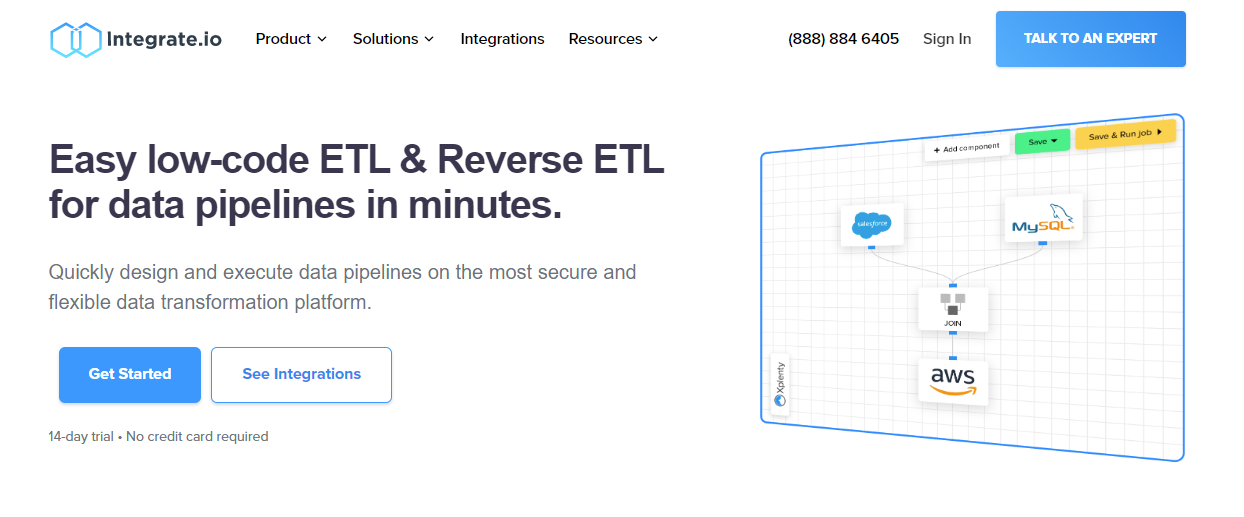
Integrate.io is a cloud-based data integration platform that prioritizes simplicity. It gives non-technical users a visual, drag-and-drop interface to build and manage data pipelines.
Supported data sources
Cloud applications (Salesforce, Hubspot, Shopify, Google Analytics), databases (MySQL, PostgreSQL, SQL Server, Oracle), cloud data warehouses (BigQuery, Redshift), file formats (CSV, JSON, XML), REST APIs, and SaaS platforms.
Integration types
- ETL
- ELT
- Real-time data streaming and webhooks
- Reverse ETL
- API-based integrations
Ideal use cases
- E-commerce data consolidation and reporting
- Sales and CRM data integration
- Marketing analytics and campaign performance tracking
- Financial reporting and business intelligence
Integrate.io pricing structure
- Core Plan:
- Fixed monthly subscription of $1,999
- Unlimited data volumes, pipelines, and connectors
- Full platform access
- Enterprise-grade needs (Custom pricing):
- Enhanced data security
- Compliance features
- Specialized support services
7. ZigiWave
Best for: Real-time, bi-directional data synchronization.
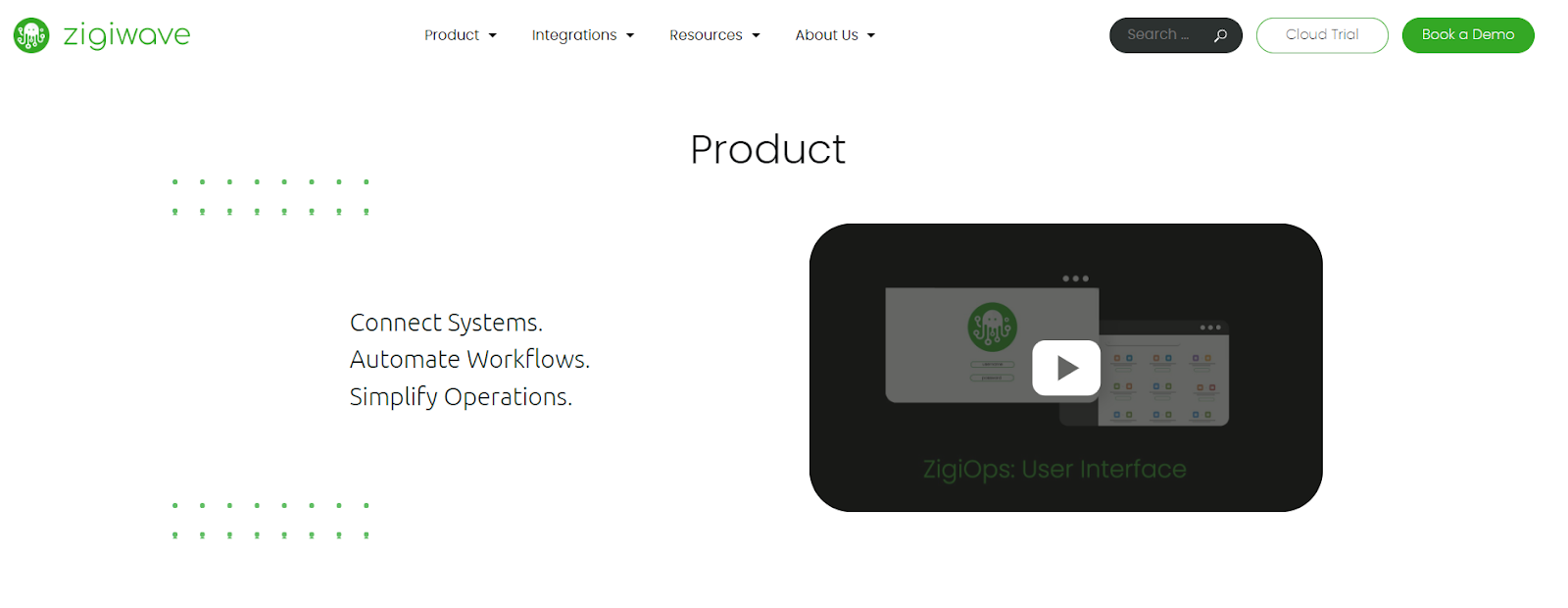
ZigiWave is a no-code data integration platform that prioritizes connecting ITSM, DevOps, and monitoring tools in real-time.
Supported data sources
IT Service management tools (ServiceNow, Jira Service Management), DevOps platforms (Jira, Azure DevOps, GitLab), security tools (Splunk, QRadar), and monitoring tools (DynaTrace, AppDynamics).
Integration types
- Real-time bi-directional synchronization
- Event-driven integrations and webhooks
- REST API-based connections
- No-code data mapping and transformation
Ideal use cases
- IT Operations and monitoring integrations
- Security incident response automation
- Cross-team collaboration
- Compliance reporting across multiple systems.
ZigiWave pricing structure
- Custom quotes available upon consultation.
- A free 30-day trial includes complete platform access, bi-directional integration, pre-built templates, and unlimited workflows.
8. Oracle Data Integrator
Best for: Enterprise-level data integration within the Oracle ecosystem.

Oracle Data Integrator is a data integration platform optimized for ELT workloads on Oracle databases and applications.
Supported data sources
Oracle databases, SQL Server, MySQL, PostgreSQL, DB2, Teradata, cloud data warehouses (Oracle Autonomous Database, Snowflake), flat files, XML, web services, JMS queues, and big data platforms (Hadoop, Spark).
Integration types
- Extract, Load, Transform (ELT)
- Extract, Transform, Load (ETL)
- Real-time data integration and Change Data Capture (CDC)
- Web services and SOA-based integrations
Ideal use cases
- Enterprise data warehousing
- Oracle-centric data migration projects
- Regulatory compliance and data governance
- Big data integrations and analytics preparation
Oracle pricing structure
- Subscription-based pricing for cloud services.
- Cloud subscriptions often include other Oracle database and middleware products within enterprise agreements.
9. Singer
Best for: Open-source, developer-friendly framework.

Singer is an open-source standard for writing scripts that move data between databases, web APIs, files, queues, and other data sources. It provides a JSON-based protocol with separate “taps” (extractors) and “targets” (loaders) that can be mixed and matched to create custom data pipelines.
Supported data sources
Databases (PostgreSQL, MySQL, SQL Server, MongoDB), SaaS applications (Salesforce, HubSpot, Google Analytics, Facebook Ads), cloud storage (S3, Google Cloud Storage), APIs, and CSV files.
Integration types
- ELT (Extract and Load, with transformation often done in-destination)
- Custom pipelines via CLI or orchestration tools (Airflow, dbt, Meltano)
Use cases
- Lightweight ELT for data engineers
- Custom data pipeline development
- Integrating with modern data stacks (Snowflake, BigQuery)
Singer pricing structure
- Free and open-source with no licensing costs
- Operational expenses may include:
- Infrastructure hosting
- Development time
- Commercial support from vendors (e.g., Meltano)
Choosing a data integration platform: Key factors to consider
There are multiple factors to consider when finding a platform that fits your infrastructure, licensing, architecture, and team needs. This section will walk through some of the core platform differentiators to help guide your evaluation.
Setup: Cloud vs on-premise vs hybrid deployment
First, you have to consider where and how your system will operate. The choice of deployment model is a big one, as it can impact system latency, compliance requirements, and overall scalability.
The 2 main options are cloud and on-premise, although more hybrid platforms are beginning to appear on the market.
Workloads requiring real-time insights (such as real-time event tracking or fraud detection) need low-latency streaming and in-memory computing capabilities. Batch processing often aligns well with on-premise environments due to their latency tolerance, legacy architecture, and compliance needs.
Licensing: Open-source vs. proprietary
The choice between open source and proprietary licensing models can impact cost, customer support, and overall platform control.
Security and compliance considerations apply to both licensing models. Either way, look for platforms that support:
- GDPR, HIPAA, and local data protection laws,
- Detailed audit logs and monitoring tools
- Incident reporting
- Data privacy features like masking and anonymization
Integration architecture: ELT vs ETL vs reverse ETL
How a platform moves, transforms, and syncs data affects the system’s overall performance and compatibility.
Many modern platforms offer libraries full of pre-built connectors, but you should verify that connectors exist for your specific systems or that custom connector development is feasible.
Team fit: Managed vs DIY
Your team’s available capacity and level of technical expertise should also factor into your decision.
Vendor ecosystem and support are key here. Look at the vendor’s market position, financial health, and long-term product roadmap. A strong partner ecosystem shows that the product is widely used, and therefore, expert help is easier to find.
Check the quality of technical support, documentation, and community resources for further insight.
Pricing structure
Costs can vary considerably from platform to platform, depending on the pricing structure and your particular situation.
The right pricing structure should support your data integration strategy and match your organization’s needs and budget.
Simplify data ingestion with Fivetran
The right data integration platform depends on your specific needs, budget, and technical requirements. Start by identifying your data sources and complexity requirements, then explore the free trials of your top candidates with real data.
Choose the platform that best balances functionality, ease of use, and the size of your organization. The right solution will improve your data processes and refine your decision-making across your business.
[CTA_MODULE]
Related posts
Start for free
Join the thousands of companies using Fivetran to centralize and transform their data.








